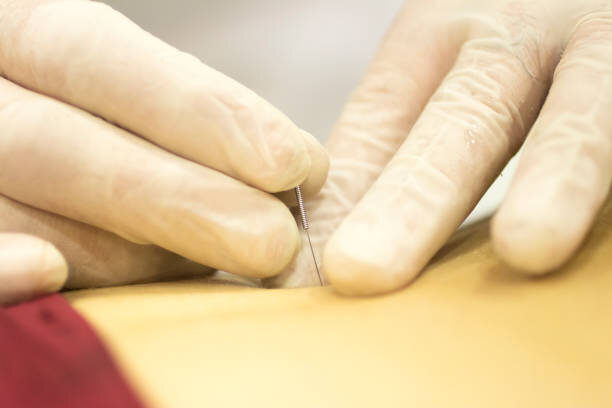Dry Needling FAQ
Many people are uncomfortable with needles, but they can be a powerful treatment. Keep reading to find out more.
What is Dry needling?
Dry needling is a procedure where thin monofilament needles are inserted into skin or muscle to decrease pain, improve muscle function and aid in tissue regeneration. The needle is “dry” because it does not involve injecting a medicine like getting a shot (wet needling). This procedure started being explored by western medicine when people who were getting injections in their muscles noticed pain relief before the medicine was actually injected. Although it is a newer technique, it has been heavily researched by medical doctors, physical therapists and chiropractors and it is safe in the hands of a properly trained practitioner.
How does it work?
Dry needling has many effects on the body that are wide reaching and get very complicated very quickly. For a full technical explanation please feel free to schedule a free consultation with one of our doctors here, and we will be happy to explain the technical side of things if you are curious. In a more general sense, it causes several physical, neurological, and chemical changes in the body which help to reduce pain, promote healing, improve function, and ease inflammation. It is particularly effective for correcting connective tissue problems in muscles, tendons, ligaments, and joints.
Types of Dry needling?
There are several different types of dry needling, all of which work very well when done properly, but they have a few key differences.
Trigger Point Dry Needling involves inserting the needle into tight, inflamed parts of muscles called trigger points. Usually the needle will be moved back and forth or twisted to help the muscle relax. This technique is very effective and has minimal discomfort in the hands of a trained professional. Deep Static Dry Needling is similar to Trigger Point Dry Needling, but the needle if often inserted deeper and does not move. Both of these therapies are very effective at getting to deeper muscles for example in the hips or thighs, but may be less appropriate in some areas where there is less tissue between skin and bone. Dr. Chase specializes in these deeper forms of needling in our office.
Superficial Dry Needling only involves inserting the needle 3-4mm into the skin, not down into the muscles. This kind of dry needling can take a few minutes more to achieve the same effects, but it does not involve moving the needle and the shallow depth of the needle helps avoid some of the more serious possible side effects (See risks below). This type of dry needling is better for working a larger area because you don’t have to be “hands on” with the needles and works well in areas where deeper insertions are not appropriate, like around the lungs, hands, etc. It is generally less effective at reaching the deeper tissues than the deeper forms of dry needling above. Dr. Zeke and Dr. Joe specialize in this form of dry needling in our office.
Is it painful?
While some types of dry needling can be uncomfortable, they are rarely painful when applied by a trained practitioner. When used appropriately, dry needling is usually a pain free treatment and you may not even feel the needles at all. Occasionally, it is possible to feel a very slight pinch for a short time when the needle is first placed, but it is definitely one of the most mild treatments available for treating muscular issues.
What kind of needles are used?
The needles are the same kind of needles used for acupuncture. They are very thin solid core needles, not hollow needles like the ones used for shots. Because these needles are so small and solid, they do not cut the skin when they are inserted, they just push the skin cells aside slightly. This is why they are pain free and do not cause damage to the tissues. We also use only brand new, single use, sterile needles for each patient.
Dry needling vs acupuncture
Dry needling and acupuncture look very similar to the untrained eye, but they are in fact very different.
Acupuncture is based on Chinese medicine principles and works to improve health by stimulating different meridians by placing needles into specific points in the body. Acupuncture draws on thousands of years of experience and development and is very effective for a variety of health issues.
Dry needling is a much newer technique that is based on western medicine and uses needles to provoke certain neurological and chemical changes in the body to aid in healing and correct musculoskeletal issues. It does not use predetermined points of needle placement, so the places where the needles are inserted can vary significantly from visit to visit.
Please note: We are not trained in acupuncture and do not practice acupuncture. If you would like to receive acupuncture, please seek out a board-certified acupuncturist in your area.
What are the risks?
Dry needling is a very safe procedure in the hands of a trained practitioner. As with any medical procedure there some risks including pain at the site of needling, bruising/bleeding, infection, and pneumothorax (punctured lung). These complications are rare and easily avoidable when done by a trained practitioner.
As noted above, most dry needling is almost entirely pain free.
While we take care to avoid any blood vessels during treatment, it is possible to have some slight bruising following treatment. This bruising is usually minimal and not painful.
We use only single-use sterile needles to minimize the risk of infection.
We use special needle placement when working around the lungs and only use the most appropriate type of treatment for each case, so puncturing a lung almost impossible.

